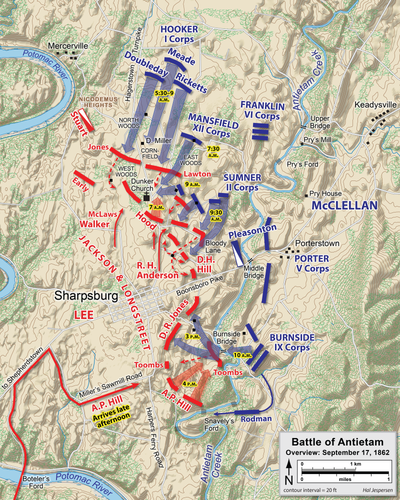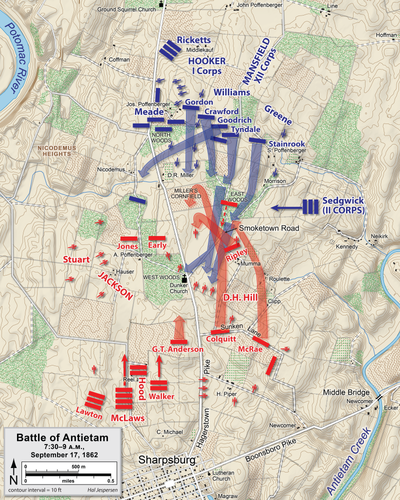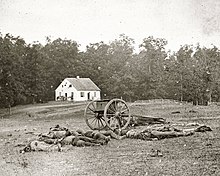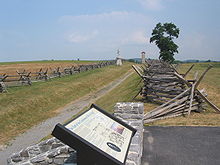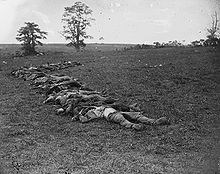Battle of Antietam
| ||||||||||||||||||||||||||||||
| ||||||||||||||||||||||||||||||
After pursuing Confederate General Robert E. Lee into Maryland, Union Army Maj. Gen. George B. McClellan launched attacks against Lee's army, in defensive positions behind Antietam Creek. At dawn on September 17, Maj. Gen. Joseph Hooker's corps mounted a powerful assault on Lee's left flank. Attacks and counterattacks swept across Miller's cornfield and fighting swirled around the Dunker Church. Union assaults against the Sunken Road eventually pierced the Confederate center, but the Federal advantage was not followed up. In the afternoon, Union Maj. Gen. Ambrose Burnside's corps entered the action, capturing a stone bridge over Antietam Creek and advancing against the Confederate right. At a crucial moment, Confederate Maj. Gen. A.P. Hill's division arrived from Harpers Ferry and launched a surprise counterattack, driving back Burnside and ending the battle. Although outnumbered two-to-one, Lee committed his entire force, while McClellan sent in less than three-quarters of his army, enabling Lee to fight the Federals to a standstill. During the night, both armies consolidated their lines. In spite of crippling casualties, Lee continued to skirmish with McClellan throughout September 18, while removing his battered army south of the river.[5]
Despite having superiority of numbers, McClellan's attacks failed to achieve concentration of mass, allowing Lee to counter by shifting forces and moving interior lines to meet each challenge. Despite ample reserve forces that could have been deployed to exploit localized successes, McClellan failed to destroy Lee's army. Nevertheless, Lee's invasion of Maryland was ended, and he was able to withdraw his army back to Virginia without interference from the cautious McClellan. Although the battle was tactically inconclusive, it had unique significance as enough of a victory to give President Abraham Lincoln the confidence to announce his Emancipation Proclamation, which discouraged the British and French governments from potential plans for recognition of the Confederacy.
Contents[show] |
[edit] Opposing forces
[edit] Confederate
| Confederate corps commanders | |||
|---|---|---|---|
|
The First Corps, under Maj. Gen. James Longstreet, consisted of the divisions of:
- Maj. Gen. Lafayette McLaws (brigades of Brig. Gens. Joseph B. Kershaw, Howell Cobb, Paul J. Semmes, and William Barksdale).
- Maj. Gen. Richard H. Anderson (brigades of Cols. Alfred Cumming, W.A. Parham, and Carnot Posey, and Brig. Gens. Lewis A. Armistead, Roger A. Pryor, and Ambrose R. Wright).
- Brig. Gen. David R. Jones (brigades of Brig. Gens. Robert A. Toombs, Thomas F. Drayton, Richard B. Garnett, James L. Kemper, and Cols. Joseph T. Walker and George T. Anderson).
- Brig. Gen. John G. Walker (brigades of Colonel Van H. Manning and Brig. Gen. Robert Ransom, Jr.).
- Brig. Gen. John Bell Hood (brigades of Cols. William T. Wofford and Evander M. Law).
- Independent brigade under Brig. Gen. Nathan G. "Shanks" Evans.
- Brig. Gen. Alexander R. Lawton (brigades of Col. Marcellus Douglass, Brig. Gen. Jubal A. Early, Col. James A. Walker, and Brig. Gen. Harry T. Hays).
- Maj. Gen. A.P. Hill (the Light Division — brigades of Brig. Gens. Lawrence O'Bryan Branch, Maxcy Gregg, James J. Archer, and William Dorsey Pender, and Cols. John M. Brockenbrough and Edward L. Thomas).
- Brig. Gen. John R. Jones (brigades of Cols. A.J. Grigsby, E. T. H. Warren, Bradley T. Johnson, and Brig. Gen. William E. Starke).
- Maj. Gen. D.H. Hill (brigades of Brig. Gens. Roswell S. Ripley, Robert E. Rodes, Samuel Garland, Jr., George B. Anderson, and Col. Alfred H. Colquitt).
[edit] Union
| Union corps commanders | ||||||
|---|---|---|---|---|---|---|
|
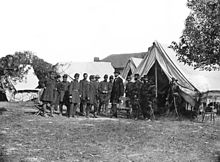
The I Corps, under Maj. Gen. Joseph Hooker, consisted of the divisions of:
- Brig. Gen. Rufus King (brigades of Col. Walter Phelps and Brig. Gens. Abner Doubleday, Marsena R. Patrick, and John Gibbon).
- Brig. Gen. James B. Ricketts (brigades of Brig. Gen. Abram Duryée, Col. William A. Christian, and Brig. Gen. George L. Hartsuff).
- Brig. Gen. George G. Meade (brigades of Brig. Gen. Truman Seymour and Col. Thomas F. Gallagher).
- Maj. Gen. Israel B. Richardson (brigades of Brig. Gen. John C. Caldwell, Brig. Gen. Thomas F. Meagher, and Col. John R. Brooke).
- Maj. Gen. John Sedgwick (brigades of Brig. Gens. Willis A. Gorman, Oliver O. Howard, and Napoleon J.T. Dana).
- Brig. Gen. William H. French (brigades of Brig. Gen. Nathan Kimball, Col. Dwight Morris, and Brig. Gen. Max Weber).
- Maj. Gen. George W. Morell (brigades of Col. James Barnes, Brig. Gen. Charles Griffin, and Col. T.B.W. Stockton).
- Brig. Gen. George Sykes (brigades of Lt. Col. Robert C. Buchanan, Major Charles S. Lovell, and Col. Gouverneur K. Warren).
- Brig. Gen. Andrew A. Humphreys (brigades of Brig. Gen. Erastus B. Tyler and Col. Peter H. Allabach).
- Maj. Gen. Henry W. Slocum (brigades of Col. Alfred T.A. Torbert, Col. Joseph J. Bartlett, and Brig. Gen. John Newton).
- Maj. Gen. William F. "Baldy" Smith (brigades of Brig. Gens. Winfield S. Hancock and William T. H. Brooks and Col. William H. Irwin).
- A division from the IV Corps under Maj. Gen. Darius N. Couch (brigades of Brig. Gens. Charles Devens, Jr., Albion P. Howe, and John Cochran).
- Brig. Gen. Orlando B. Willcox (brigades of Cols. Benjamin C. Christ and Thomas Welsh).
- Brig. Gen. Samuel D. Sturgis (brigades of Brig. Gens. James Nagle and Edward Ferrero).
- Brig. Gen. Isaac P. Rodman (brigades of Cols. Harrison S. Fairchild and Edward Harland).
- Kanawha Division, under Brig. Gen. Jacob D. Cox (brigades of Cols. Hugh Ewing and George Crook).
- Brig. Gen. Alpheus S. Williams (brigades of Brig. Gens. Samuel W. Crawford and George H. Gordon).
- Brig. Gen. George S. Greene (brigades of Lt. Col. Hector Tyndale, Col. Henry J. Stainrook, and Col. William B. Goodrich).
- Cavalry division of Brig. Gen. Alfred Pleasonton (brigades of Maj. Charles J. Whiting and Cols. John F. Farnsworth, Richard H. Rush, Andrew T. McReynolds, and Benjamin F. Davis).
[edit] Battle
Near the town of Sharpsburg, Lee deployed his available forces behind Antietam Creek along a low ridge, starting on September 15. While it was an effective defensive position, it was not an impregnable one. The terrain provided excellent cover for infantrymen, with rail and stone fences, outcroppings of limestone, and little hollows and swales. The creek to their front was only a minor barrier, ranging from 60 to 100 feet (18–30 m) in width, and was fordable in places and crossed by three stone bridges each a mile (1.5 km) apart. It was also a precarious position because the Confederate rear was blocked by the Potomac River and only a single crossing point, Boteler's Ford at Shepherdstown, was nearby should retreat be necessary. (The ford at Williamsport, Maryland, was 10 miles (16 km) northwest from Sharpsburg and had been used by Jackson in his march to Harpers Ferry. The disposition of Union forces during the battle made it impractical to consider retreating in that direction.) And on September 15, the force under Lee's immediate command consisted of no more than 18,000 men, only a third the size of the Federal army.[8]The first two Union divisions arrived on the afternoon of September 15 and the bulk of the remainder of the army late that evening. Although an immediate Union attack on the morning of September 16 would have had an overwhelming advantage in numbers, McClellan's trademark caution and his belief that Lee had as many as 100,000 men at Sharpsburg caused him to delay his attack for a day.[9] This gave the Confederates more time to prepare defensive positions and allowed Longstreet's corps to arrive from Hagerstown and Jackson's corps, minus A.P. Hill's division, to arrive from Harpers Ferry. Jackson defended the left (northern) flank, anchored on the Potomac, Longstreet the right (southern) flank, anchored on the Antietam, a line that was about 4 miles (6 km) long. (As the battle progressed and Lee shifted units, these corps boundaries overlapped considerably.)[10]
On the evening of September 16, McClellan ordered Hooker's I Corps to cross Antietam Creek and probe the enemy positions. Meade's division cautiously attacked the Confederates under Hood near the East Woods. After darkness, artillery fire continued as McClellan continued to position his troops. McClellan's plan was to overwhelm the enemy's left flank. He arrived at this decision because of the configuration of bridges over the Antietam. The lower bridge (which would soon be named Burnside Bridge) was dominated by Confederate positions on the bluffs overlooking it. The middle bridge, on the road from Boonsboro, was subject to artillery fire from the heights near Sharpsburg. But the upper bridge was 2 miles (3 km) east of the Confederate guns and could be crossed safely. McClellan planned to commit more than half his army to the assault, starting with two corps, supported by a third, and if necessary a fourth. He intended to launch a simultaneous diversionary attack against the Confederate right with a fifth corps, and he was prepared to strike the center with his reserves if either attack succeeded.[11] The skirmish in the East Woods served to signal McClellan's intentions to Lee, who prepared his defenses accordingly. He shifted men to his left flank and sent urgent messages to his two commanders who had not yet arrived on the battlefield: Lafayette McLaws with two divisions and A.P. Hill with one division.[12]
McClellan's plans were ill-coordinated and were executed poorly. He issued to each of his subordinate commanders only the orders for his own corps, not general orders describing the entire battle plan. The terrain of the battlefield made it difficult for those commanders to monitor events outside of their sectors, and McClellan's headquarters were more than a mile in the rear (at the Philip Pry house, east of the creek), making it difficult for him to control the separate corps. Therefore, the battle progressed the next day as essentially three separate, mostly uncoordinated battles: morning in the northern end of the battlefield, mid-day in the center, and afternoon in the south. This lack of coordination and concentration of McClellan's forces almost completely nullified the two-to-one advantage the Union enjoyed and allowed Lee to shift his defensive forces to meet each offensive.[13]
[edit] Morning
The battle opened at dawn (about 5:30 a.m.) on September 17 with an attack down the Hagerstown Turnpike by the Union I Corps under Joseph Hooker. Hooker's objective was the plateau on which the Dunker Church sat, a modest whitewashed building belonging to a local sect of German Baptists. Hooker had approximately 8,600 men, little more than the 7,700 defenders under Stonewall Jackson, and this slight disparity was more than offset by the Confederates' strong defensive positions.[14] Abner Doubleday's division moved on Hooker's right, James Ricketts's moved on the left into the East Woods, and George Meade's Pennsylvania Reserves division deployed in the center and slightly to the rear. Jackson's defense consisted of the divisions under Alexander Lawton and John R. Jones in line from the West Woods, across the Turnpike, and along the southern end of the Miller Cornfield. Four brigades were held in reserve inside the West Woods.[15]As the first Union men emerged from the North Woods and into the Cornfield, an artillery duel erupted. Confederate fire was from the horse artillery batteries under Jeb Stuart to the west and four batteries under Col. Stephen D. Lee on the high ground across the pike from the Dunker Church to the south. Union return fire was from nine batteries on the ridge behind the North Woods and four batteries of 20-pounder Parrott rifles, 2 miles (3 km) east of Antietam Creek. The conflagration caused heavy casualties on both sides and was described by Col. Lee as "artillery Hell."[16]
Seeing the glint of Confederate bayonets concealed in the Cornfield, Hooker halted his infantry and brought up four batteries of artillery, which fired shell and canister over the heads of the Federal infantry, covering the field. All at once, the cornfield exploded into chaos as a savage battle raged through the area. Men beat each other over the heads with rifle butts and stabbed each other with bayonets. Officers rode around on their horses sweating and cursing and yelling orders no one could hear in the noise. Rifles became hot and fouled from too much firing. The air was filled with a hail of bullets and shells.[17]
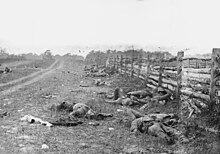
The reinforcements that Duryée had expected—brigades under Brig. Gen. George L. Hartsuff and Col. William A. Christian—had difficulties reaching the scene. Hartsuff was wounded by a shell, and Christian dismounted and fled to the rear in terror. When the men were rallied and advanced into the Cornfield, they met the same artillery and infantry fire as their predecessors. As the superior Union numbers began to tell, the Louisiana "Tiger" Brigade under Harry Hays entered the fray and forced the Union men back to the East Woods. The casualties received by the 12th Massachusetts Infantry, 67%, were the highest of any unit that day.[18] The Tigers were beaten back eventually when the Federals brought up a battery of 3-inch ordnance rifles and rolled them directly into the Cornfield, point-blank fire that slaughtered the Tigers, who lost 323 of their 500 men.[19]
Confederate reinforcements arrived just after 7 a.m. The divisions under McLaws and Richard H. Anderson arrived following a night march from Harpers Ferry. Around 7:15, General Lee moved George T. Anderson's Georgia brigade from the right flank of the army to aid Jackson. At 7 a.m., Hood's division of 2,300 men advanced through the West Woods and pushed the Union troops back through the Cornfield again. The Texans attacked with particular ferocity because as they were called from their reserve position they were forced to interrupt the first hot breakfast they had had in days. They were aided by three brigades of D.H. Hill's division arriving from the Mumma Farm, southeast of the Cornfield, and by Jubal Early's brigade, pushing through the West Woods from the Nicodemus Farm, where they had been supporting Jeb Stuart's horse artillery. Some officers of the Iron Brigade rallied men around the artillery pieces of Battery B, 4th U.S. Artillery, and Gibbon himself saw to it that his previous unit did not lose a single caisson.[23] Hood's men bore the brunt of the fighting, however, and paid a heavy price—60% casualties—but they were able to prevent the defensive line from crumbling and held off the I Corps. When asked by a fellow officer where his division was, Hood replied, "Dead on the field."[24]
Hooker's men had also paid heavily but without achieving their objectives. After two hours and 2,500 casualties, they were back where they started. The Cornfield, an area about 250 yards (230 m) deep and 400 yards (400 m) wide, was a scene of indescribable destruction. It was estimated that the Cornfield changed hands no fewer than 15 times in the course of the morning.[25] Major Rufus R. Dawes, who assumed command of Iron Brigade's 6th Wisconsin Regiment during the battle, later compared the fighting around the Hagerstown Turnpike with the stone wall at Fredericksburg, Spotsylvania's "Bloody Angle", and the slaughter pen of Cold Harbor, insisting that "the Antietam Turnpike surpassed them all in manifest evidence of slaughter."[26] Hooker called for support from the 7,200 men of Mansfield's XII Corps.
The new recruits of Mansfield's 1st Division made no progress against Hood's line, which was reinforced by D.H. Hill's divisions under Colquitt and McRae. The 2nd Division of the XII Corps, under George Sears Greene, however, broke through McRae's men, who fled under the mistaken belief that they were about to be trapped by a flanking attack. This breach of the line forced Hood and his men, outnumbered, to regroup in the West Woods, where they had started the day.[18] Greene was able to reach the Dunker Church, Hooker's original objective, and drove off Stephen Lee's batteries. Federal forces held most of the ground to the east of the turnpike.
Hooker attempted to gather the scattered remnants of his I Corps to continue the assault, but a Confederate sharpshooter spotted the general's conspicuous white horse and shot Hooker through the foot. Command of his I Corps fell to General Meade, since Hooker's senior subordinate, James B. Ricketts, had also been wounded. But with Hooker removed from the field, there was no general left with the authority to rally the men of the I and XII Corps. Greene's men came under heavy fire from the West Woods and withdrew from the Dunker Church.
The final actions in the morning phase of the battle were around 10 a.m., when two regiments of the XII Corps advanced, only to be confronted by the division of John G. Walker, newly arrived from the Confederate right. They fought in the area between the Cornfield in the West Woods, but soon Walker's men were forced back by two brigades of Greene's division, and the Federal troops seized some ground in the West Woods.
The morning phase ended with casualties on both sides of almost 13,000, including two Union corps commanders.[30]
[edit] Mid-day
By mid-day, the action had shifted to the center of the Confederate line. Sumner had accompanied the morning attack of Sedgwick's division, but another of his divisions, under French, lost contact with Sumner and Sedgwick and inexplicably headed south. Eager for an opportunity to see combat, French found skirmishers in his path and ordered his men forward. By this time, Sumner's aide (and son) located French, described the terrible fighting in the West Woods and relayed an order for him to divert Confederate attention by attacking their center.[31]French confronted D.H. Hill's division. Hill commanded about 2,500 men, less than half the number under French, and three of his five brigades had been torn up during the morning combat. This sector of Longstreet's line was theoretically the weakest. But Hill's men were in a strong defensive position, atop a gradual ridge, in a sunken road worn down by years of wagon traffic, which formed a natural trench.[32]
French launched a series of brigade-sized assaults against Hill's improvised breastworks at around 9:30 a.m. The first brigade to attack, mostly inexperienced troops commanded by Brig. Gen. Max Weber, was quickly cut down by heavy rifle fire; neither side deployed artillery at this point. The second attack, more raw recruits under Col. Dwight Morris, was also subjected to heavy fire but managed to beat back a counterattack by the Alabama Brigade of Robert Rodes. The third, under Brig. Gen. Nathan Kimball, included three veteran regiments, but they also fell to fire from the sunken road. French's division suffered 1,750 casualties (of his 5,700 men) in under an hour.[33]
Reinforcements were arriving on both sides, and by 10:30 a.m. Robert E. Lee sent his final reserve division—some 3,400 men under Maj. Gen. Richard H. Anderson—to bolster Hill's line and extend it to the right, preparing an attack that would envelop French's left flank. But at the same time, the 4,000 men of Maj. Gen. Israel B. Richardson's division arrived on French's left. This was the last of Sumner's three divisions, which had been held up in the rear by McClellan as he organized his reserve forces.[34] Richardson's fresh troops struck the first blow.
Leading off the fourth attack of the day against the sunken road was the Irish Brigade of Brig. Gen. Thomas F. Meagher. As they advanced with emerald green flags snapping in the breeze, a regimental chaplain, Father William Corby, rode back and forth across the front of the formation shouting words of conditional absolution prescribed by the Roman Catholic Church for those who were about to die. (Corby performed a similar service at Gettysburg in 1863.) The mostly Irish immigrants lost 540 men to heavy volleys before they were ordered to withdraw.[35]
Gen. Richardson personally dispatched the brigade of Brig. Gen. John C. Caldwell into battle around noon (after being told that Caldwell was in the rear, behind a haystack), and finally the tide turned. Anderson's Confederate division had been little help to the defenders after Gen. Anderson was wounded early in the fighting. Other key leaders were lost as well, including George B. Anderson (no relation; Anderson's successor, Col. Charles C. Tew of the 2nd North Carolina, was killed minutes after assuming command)[36] and Col. John B. Gordon of the 6th Alabama. (Gordon received four serious wounds in the fight. He lay unconscious, face down in his cap, and later told colleagues that he should have smothered in his own blood, except for the act of an unidentified Yankee, who had earlier shot a hole in his cap, which allowed the blood to drain.)[37] Rodes was wounded in the thigh but was still on the field. These losses contributed directly to the confusion of the following events.
Richardson's men were in hot pursuit when massed artillery hastily assembled by Gen. Longstreet drove them back. A counterattack with 200 men led by D.H. Hill got around the Federal left flank near the sunken road, and although they were driven back by a fierce charge of the 5th New Hampshire, this stemmed the collapse of the center. Reluctantly, Richardson ordered his division to fall back to north of the ridge facing the sunken road. His division lost about 1,000 men. Col. Barlow was severely wounded, and Richardson mortally wounded.[39] Winfield S. Hancock assumed division command. Although Hancock would have an excellent future reputation as an aggressive division and corps commander, the unexpected change of command sapped the momentum of the Federal advance.[40]
The carnage from 9:30 a.m. to 1:00 p.m. on the sunken road gave it the name Bloody Lane, leaving about 5,600 casualties (Union 3,000, Confederate 2,600) along the 800-yard (700 m) road. And yet a great opportunity presented itself. If this broken sector of the Confederate line were exploited, Lee's army would have been divided in half and possibly defeated. There were ample forces available to do so. There was a reserve of 3,500 cavalry and the 10,300 infantrymen of Gen. Porter's V Corps, waiting near the middle bridge, a mile away. The VI Corps had just arrived with 12,000 men. Maj. Gen. William B. Franklin of the VI Corps was ready to exploit this breakthrough, but Sumner, the senior corps commander, ordered him not to advance. Franklin appealed to McClellan, who left his headquarters in the rear to hear both arguments but backed Sumner's decision, ordering Franklin and Hancock to hold their positions.[41]
Later in the day, the commander of the other reserve unit near the center, the V Corps, Maj. Gen. Fitz John Porter, heard recommendations from Maj. Gen. George Sykes, commanding his 2nd Division, that another attack be made in the center, an idea that intrigued McClellan. However, Porter is said to have told McClellan, "Remember, General, I command the last reserve of the last Army of the Republic." McClellan demurred and another opportunity was lost.[42]
[edit] Afternoon
The action moved to the southern end of the battlefield. McClellan's plan called for Maj. Gen. Ambrose Burnside and the IX Corps to conduct a diversionary attack in support of Hooker's I Corps, hoping to draw Confederate attention away from the intended main attack in the north. However, Burnside was instructed to wait for explicit orders before launching his attack, and those orders did not reach him until 10 a.m.[43] Burnside was strangely passive during preparations for the battle. He was disgruntled that McClellan had abandoned the previous arrangement of "wing" commanders reporting to him. Previously, Burnside had commanded a wing that included both the I and IX Corps and now he was responsible only for the IX Corps. Implicitly refusing to give up his higher authority, Burnside treated first Maj. Gen. Jesse L. Reno (killed at South Mountain) and then Brig. Gen. Jacob D. Cox of the Kanawha Division as the corps commander, funneling orders to the corps through him.Burnside had four divisions (12,500 troops) and 50 guns east of Antietam Creek. Facing him was a force that had been greatly depleted by Lee's movement of units to bolster the Confederate left flank. At dawn, the divisions of Brig. Gens. David R. Jones and John G. Walker stood in defense, but by 10 a.m. all of Walker's men and Col. George T. Anderson's Georgia brigade had been removed. Jones had only about 3,000 men and 12 guns available to meet Burnside. Four thin brigades guarded the ridges near Sharpsburg, primarily a low plateau known as Cemetery Hill. The remaining 400 men—the 2nd and 20th Georgia regiments, under the command of Brig. Gen. Robert Toombs, with two artillery batteries—defended Rohrbach's Bridge, a three-span, 125-foot (38 m) stone structure that was the southernmost crossing of the Antietam.[44] It would become known to history as Burnside's Bridge because of the notoriety of the coming battle. The bridge was a difficult objective. The road leading to it ran parallel to the creek and was exposed to enemy fire. The bridge was dominated by a 100-foot (30 m) high wooded bluff on the west bank, strewn with boulders from an old quarry, making infantry and sharpshooter fire from good covered positions a dangerous impediment to crossing.
While Rodman's division was out of touch, slogging toward Snavely's Ford, Burnside and Cox directed a second assault at the bridge by one of Sturgis's brigades, led by the 2nd Maryland and 6th New Hampshire. They also fell prey to the Confederate sharpshooters and artillery, and their attack fell apart.[49] By this time it was noon, and McClellan was losing patience. He sent a succession of couriers to motivate Burnside to move forward. He ordered one aide, "Tell him if it costs 10,000 men he must go now." He increased the pressure by sending his inspector general, Col. Delos B. Sackett, to confront Burnside, who reacted indignantly: "McClellan appears to think I am not trying my best to carry this bridge; you are the third or fourth one who has been to me this morning with similar orders."[50]
The third attempt to take the bridge was at 12:30 p.m. by Sturgis's other brigade, commanded by Brig. Gen. Edward Ferrero. It was led by the 51st New York and the 51st Pennsylvania, who, with adequate artillery support and a promise that a recently canceled whiskey ration would be restored if they were successful, charged downhill and took up positions on the east bank. Maneuvering a captured light howitzer into position, they fired double canister down the bridge and got within 25 yards (23 m) of the enemy. By 1 p.m., Confederate ammunition was running low, and word reached Toombs that Rodman's men were crossing Snavely's Ford on their flank. He ordered a withdrawal. His Georgians had cost the Federals more than 500 casualties, giving up fewer than 160 themselves. And they had stalled Burnside's assault on the southern flank for more than three hours.[51]
Burnside's assault stalled again on its own. His officers had neglected to transport ammunition across the bridge, which was itself becoming a bottleneck for soldiers, artillery, and wagons. This represented another two-hour delay. Gen. Lee used this time to bolster his right flank. He ordered up every available artillery unit, although he made no attempt to strengthen D.R. Jones's badly outnumbered force with infantry units from the left. Instead, he counted on the arrival of A.P. Hill's Light Division, currently embarked on an exhausting 17 mile (27 km) march from Harpers Ferry. By 2 p.m., Hill's men had reached Boteler's Ford, and Hill was able to confer with the relieved Lee at 2:30, who ordered him to bring up his men to the right of Jones.[52]
The Federals were completely unaware that 3,000 new men would be facing them. Burnside's plan was to move around the weakened Confederate right flank, converge on Sharpsburg, and cut Lee's army off from Boteler's Ford, their only escape route across the Potomac. At 3 p.m., Burnside left Sturgis's division in reserve on the west bank and moved west with over 8,000 troops (most of them fresh) and 22 guns for close support.[53]
An initial assault led by the 79th New York "Cameron Highlanders" succeeded against Jones's outnumbered division, which was pushed back past Cemetery Hill and to within 200 yards (200 m) of Sharpsburg. Farther to the left, Rodman's division advanced toward Harpers Ferry Road. Its lead brigade, under Col. Harrison Fairchild, containing several colorful Zouaves of the 9th New York, came under heavy shellfire from a dozen enemy guns mounted on a ridge to their front, but they kept pushing forward. There was panic in the streets of Sharpsburg, clogged with retreating Confederates. Of the five brigades in Jones's division, only Toombs's brigade was still intact, but he had only 700 men.[54]

The IX Corps had suffered casualties of about 20% but still possessed twice the number of Confederates confronting them. Unnerved by the collapse of his flank, Burnside ordered his men all the way back to the west bank of the Antietam, where he urgently requested more men and guns. McClellan was able to provide just one battery. He said, "I can do nothing more. I have no infantry." In fact, however, McClellan had two fresh corps in reserve, Porter's V and Franklin's VI, but he was too cautious, concerned about an imminent massive counterstrike by Lee. Burnside's men spent the rest of the day guarding the bridge they had suffered so much to capture.[56]
[edit] Aftermath

On the morning of September 18, Lee's army prepared to defend against a Federal assault that never came. After an improvised truce for both sides to recover and exchange their wounded, Lee's forces began withdrawing across the Potomac that evening to return to Virginia.[60]
President Lincoln was disappointed in McClellan's performance. He believed that McClellan's cautious and poorly coordinated actions in the field had forced the battle to a draw rather than a crippling Confederate defeat. Historian Stephen Sears agrees.[61]
In making his battle against great odds to save the Republic, General McClellan had committed barely 50,000 infantry and artillerymen to the contest. A third of his army did not fire a shot. Even at that, his men repeatedly drove the Army of Northern Virginia to the brink of disaster, feats of valor entirely lost on a commander thinking of little beyond staving off his own defeat.The president was even more astonished that from September 17 to October 26, despite repeated entreaties from the War Department and the president himself, McClellan declined to pursue Lee across the Potomac, citing shortages of equipment and the fear of overextending his forces. General-in-Chief Henry W. Halleck wrote in his official report, "The long inactivity of so large an army in the face of a defeated foe, and during the most favorable season for rapid movements and a vigorous campaign, was a matter of great disappointment and regret."[62] Lincoln relieved McClellan of his command of the Army of the Potomac on November 7, effectively ending the general's military career.
– Stephen W. Sears, Landscape Turned Red

No other campaign and battle in the war had such momentous, multiple consequences as Antietam. In July 1863 the dual Union triumphs at Gettysburg and Vicksburg struck another blow that blunted a renewed Confederate offensive in the East and cut off the western third of the Confederacy from the rest. In September 1864 Sherman's capture of Atlanta reversed another decline in Northern morale and set the stage for the final drive to Union victory. These also were pivotal moments. But they would never have happened if the triple Confederate offensives in Mississippi, Kentucky, and most of all Maryland had not been defeated in the fall of 1862.The battle is commemorated at Antietam National Battlefield.
– James M. McPherson, Crossroads of Freedom
[edit] Gallery
[edit] See also
| Wikimedia Commons has media related to: Battle of Antietam |










